Backpacking Smart: Why I Take a Hatchet

All weights listed in this article include the sheath
When backpacking, a compact hatchet should be packed for emergencies. If you become lost or injured they can be used to build fires, shelter, or signal for help. But, they are also handy once you have made camp for kindling or camp crafts. Although many will say they are too heavy.
This is going to be controversial. I’m not an ultra-light hiker, but I do make an effort to pack light and efficiently as possible. And still, I always carry a compact hatchet when I go backpacking.
Many backpackers will say you don’t need an axe or hatchet – and often that is true. And it will depend on your environment. But, I like to be prepared when I am in the wilderness and far from potential help. And after using both a knife and a hatchet for years, I’m convinced a hatchet is what I want if things go south.
My favorite backpacking axe is the Fiskars X5. More details on this axe and other options I’ve tested further down.
This is just a hobby, but if you buy through a link I may get a commission that supports the site. Thanks!
Campsite Tasks are Easier but not the Point
A small hatchet can be convenient for tasks like splitting wood on campsites. It’s nice to have in these scenarios, but a medium-large knife can baton through a few pieces of kindling to get a fire started if needed. And a knife is often better for shaving tinder.
Plus you often don’t have fires when backpacking anyway – you cook with a stove. So this is not the main you should carry an axe.
Carrying an Axe Can Save Your Life on the Trail
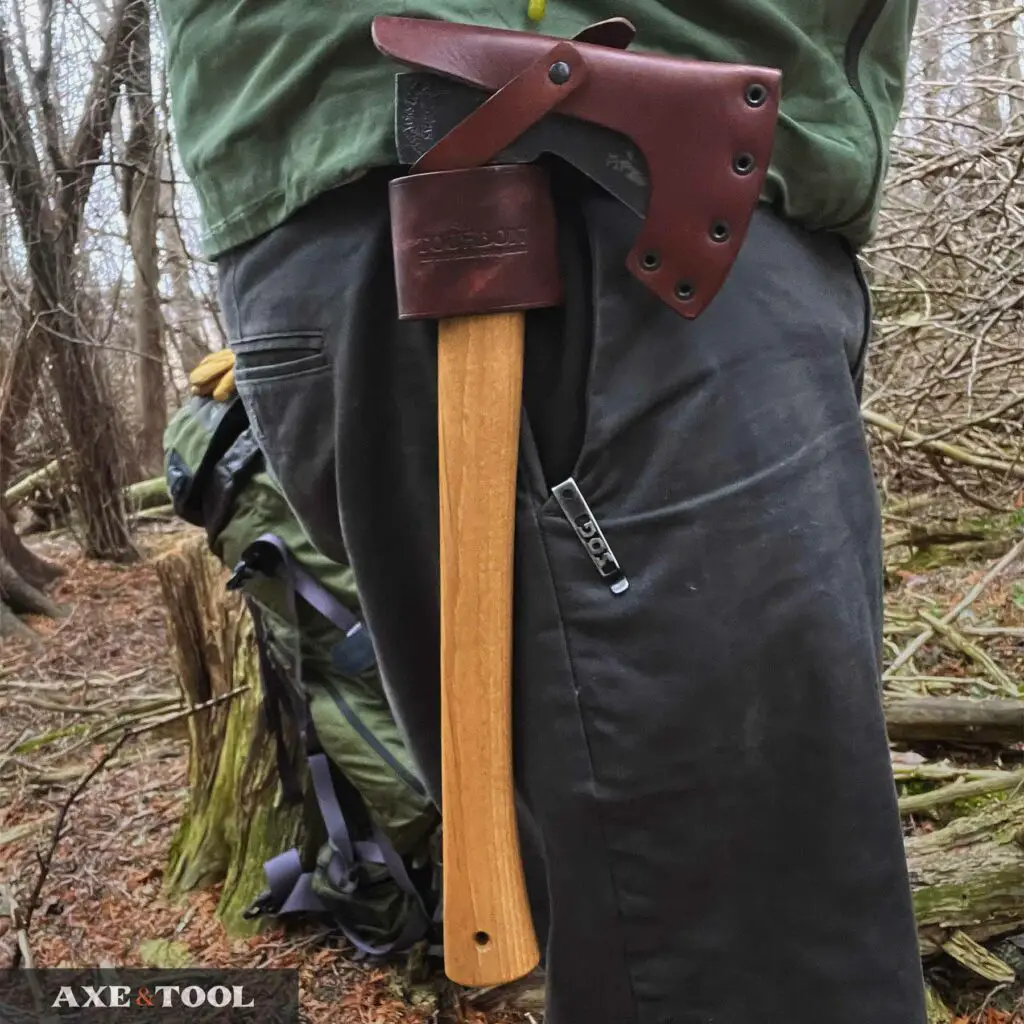
I don’t normally take a belt loop, but I was testing axes
While backpacking isn’t a dangerous activity – accidents happen, people get lost and the seriousness is compounded by how far you are from help.
An axe or hatchet is an incredibly useful tool in backwood emergencies as it can be used to process wood for a fire, carve or shape make-shift tools, build shelter, clear canopy, or blaze a trail to improve your chances of being found.
Build Robust Fires that Last
This one is obvious, but fire is a big deal in a survival scenario – it can be used for heat, comfort/morale, cooking, or as a signal for help to find you. Whether someone is hurt and in shock, or you get stuck somewhere unexpected you may need to make an unplanned fire quickly – and the ability to efficiently gather fuel is key.
You usually don’t get to choose when these things happen, so you may be stuck with limited options for dry wood.
You want to be able to use larger pieces of wood to keep the fire going while you work on other things or try and get some sleep. If you can only use sticks from the ground you will be constantly feeding the fire, and be unable to get any rest or get anything else done. Making your situation worse.

Effectively chopped through 5″ wide semi-seasoned deadwood
Axes Can Build Shelter or Craft Other Tools
The nice thing about backpacking is you likely have your shelter on your back, but you still may need to use deadwood, branches, or small trees in an emergency. Whether it’s to make a split, stretcher, or even a makeshift stretcher.
This may sound extreme (and hopefully it never happens) but if an accident happens you don’t want to waste time or energy.
Axes Can Help You Get Rescued
I already mentioned fire being used for signaling, but it can also help you find your way and lead others to you.
An axe can be used to blaze a trail by slashing segments of bark off trees as you walk. This leaves a marked trail of “breadcrumbs” for you to follow, but will also lead any rescue parties that come across it right to you.
The Benefits of a Hatchet Over a Knife
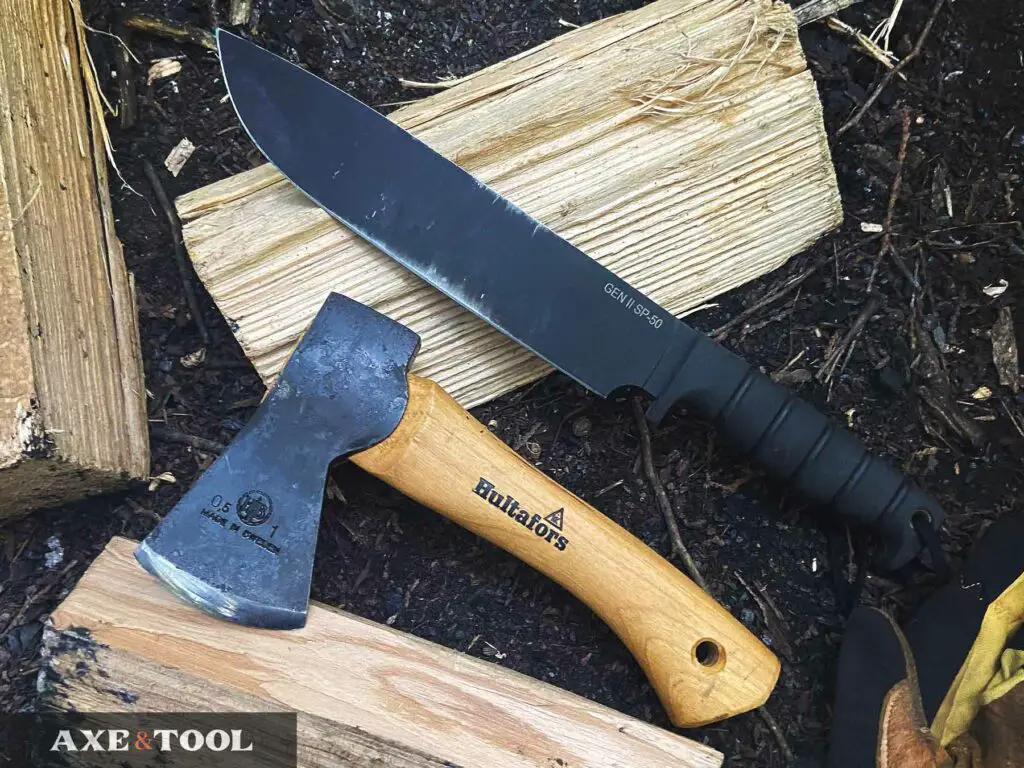
Hultafors Ågelsjön aka Hults Bruk Jonaker (26oz | 745g)
Many people will argue that all the survival tasks listed above can be done with a lighter and more compact survival knife – and there is some truth in that (like I said I carried a knife for years).
You can certainly chop, shape, and even split wood with a knife. But, there are a few reasons that convinced me to switch to a hatchet – and I never looked back.
1. Hatchets are faster and more efficient
The weight of the head is concentrated behind a shorter cutting edge, and a wedge-shaped head is what makes a hatchet perform well when chopping or splitting. In an emergency you need to move quickly and conserve your energy – and a good hatchet will allow you to do this compared to a knife.
A wedge-shaped hatchet head will also be easier to remove if it gets stuck in a piece of wood. I have had my knife get VERY stuck in a log before – wasting time and energy.
These are also the main reasons the thin ultra-light “pack axes” are not a good option.
2. Hatchets can be used one-handed if injured
the weight of the axe head is doing most of the work, which means that even with one hand, you can still be efficient when chopping. And is much easier to use when your adrenaline is pumping. All it takes is your gross motor skills to swing, and there is no chance of your hand slipping and getting cut on the blade (making things worse).
3. Hatchets don’t need special skills
An axe is much easier than a knife to hand off to someone else an have them use it successfully to chop or split wood. Even if you know how to split wood with a knife – not everyone in your group will – and what if you are the one injured?
4. The right hatchet doesn’t weigh more
What surprised me is many good hatchets weigh the same or less than my old large survival knife. Now my knife was big (12″ blade) – and it weighed less than an axe on its own. But the sheath for a 12″ blade added a lot of extra weight, whereas a small leather mask on an axe weighs almost nothing. So similar weights overall, but the axe is all useful weight.
My Favorite 3 Backpacking Axes
The goal for all backpacking gear is to be compact and light – HOWEVER, you want to avoid most “ultra-light” and “pack axes”. These slim all-steel “axes” are more like an axe-shaped knife, and they won’t perform well. I have more info in my comparison of the Fiskars X5 vs Gerber Pack Axe.
I will do a more in-depth comparison of all the models of backpacking axe I have tested, but these 3 are the ones that have stood out to me most.
| Axe | Length | Weight | Price |
|---|---|---|---|
| Fiskars X5 | 9″ | 21.5oz (1.35lb) | $$ |
| Lexivon 9 | 9″ | 20oz (1.25lb) | $ |
| Gransfors Bruk Outdoor Axe | 14″ | 19.75oz (1.23lb) | $$$$ |
The Fiskars X5 is made for backpacking
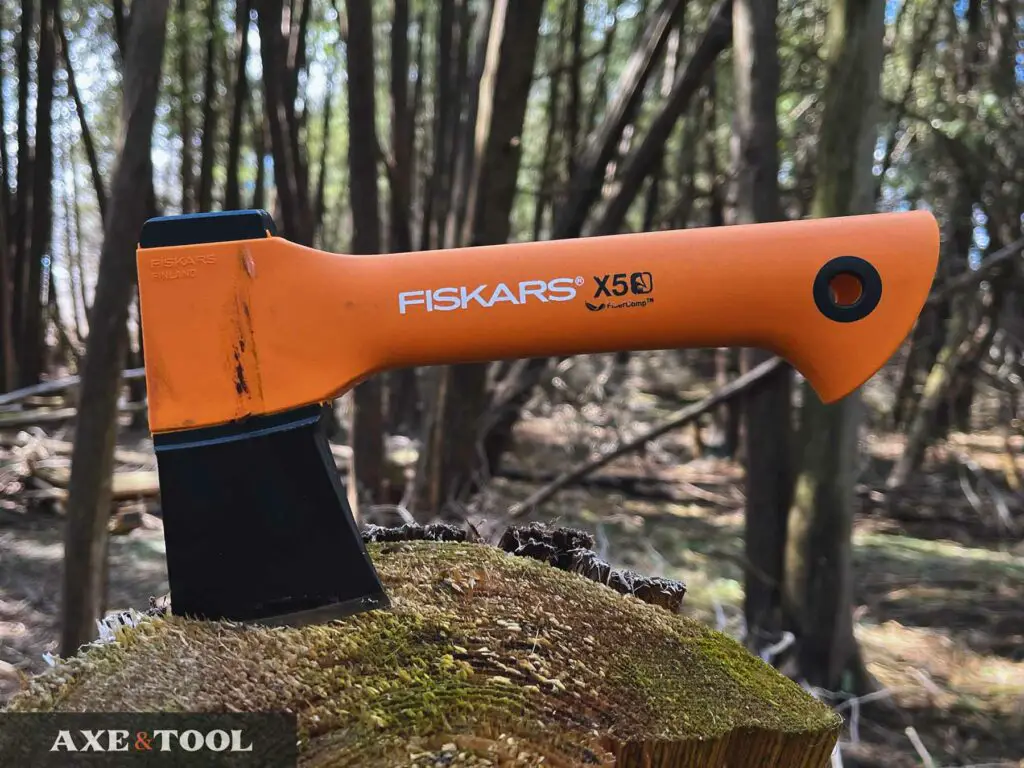
The X5 is the axe I have carried most while backpacking the last couple of years despite owning much more expensive options.
The Fiskars X5 checks every box for what makes a good backpacking axe. It has an efficient 1lb wedge-shaped head, but still only weighs a total of 1.35 lbs (21.5oz | 613g) with a sheath. So most of the weight is smart “working weight”. And this means it performs surprisingly well at both chopping and splitting tasks despite its small size.
Plus it’s affordable to top it all off. I bought an aftermarket leather sheath, which reduces the footprint and weight even more.
I have a lot more info about Fiskars on the site if you want to do more research.
The Gerber 9 is just a Black Fiskars X5
Fun fact – Gerber is owned by Fiskars. So, if you don’t like orange this axe is also sold as the Gerber 9, and it’s all black with a green sheath. It can sometimes be a few bucks cheaper than the Fiskars version, but they are identical other than color – here is the Gerber 9 on amazon.
Gerber makes ANOTHER very similar-looking axe called the “Gerber Gator” which is made in Thailand and of lower quality.
The Lexivon V9 is a budget X5
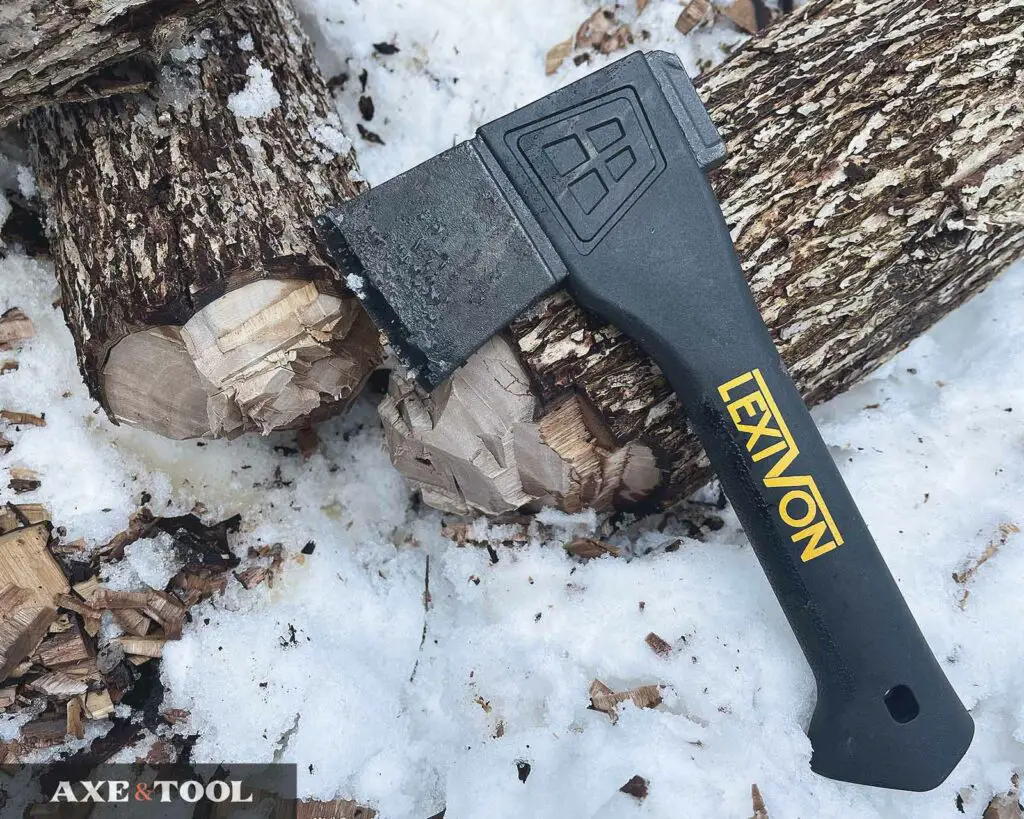
I like this axe WAY more than I was expecting to. The compact Lexivon V9 is essentially a knock-off Fiskars X5 that is around half the price (see on amazon).
I was expecting it to be trash like most of the other axes at this price point – but it performs pretty darn well. It has a similar head shape and actually manages to weigh slightly less. I don’t think the steel is as good as Fiskars, and the finish is noticeably lower quality – but it works well.
The larger models of Lexivon have issues – and I wouldn’t recommend them. But in this size and role, I think it could be considered (Although I would still take the Fiskars first).
It comes with a little “bag-clip” style plastic sheath that is odd – but really light and compact.
The Gransfors Bruk Outdoor Axe Does it Differently
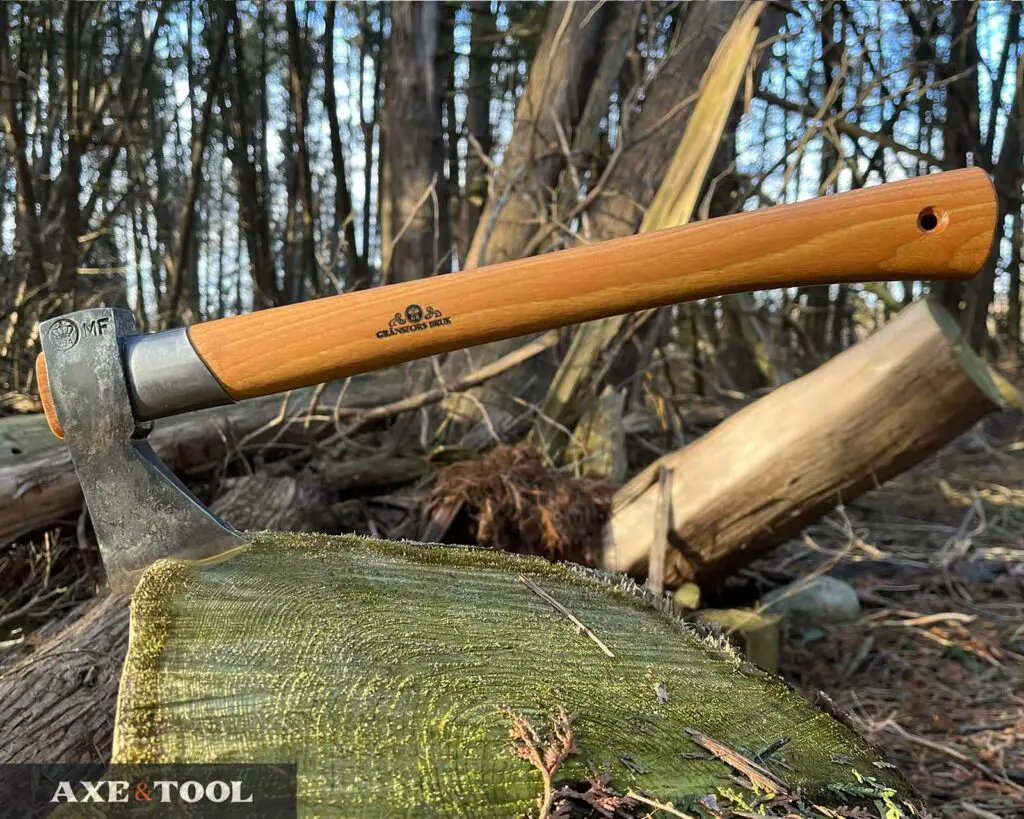
This is a very interesting option but at $200+ it’s not for everyone.
Unlike the other options that use a full-size hatchet head on a compact handle, the Outdoor Axe is unique and puts a lighter 0.75lb (approx) head on a full-size 14″ handle. This longer handle compensates for the lighter head by allowing you to whip it much more quickly.
The weight reduction in the head does still impact performance when chopping through a 5-6″ log, but it’s still very capable of it – and the long handle makes it much more comfortable and pleasant to do.
The smaller sharp head is better than either of the others for small carving and detail work, and the design really lends to being a “belt axe” that can be used interchangeably like a knife.
Here is the Outdoor Axe on Amazon, but they also have a hand-hatchet model that is much more like the Fiskars model here.
I have more details and pictures of the outdoor axe in this comparison with another Gransfors Bruk axe.
Please comment below If I missed something or if you have any questions. I do my best to respond to everyone.
About the author:
About the author:
Jim Bell | Site Creator
I’m just a guy who likes axes. I got tired of only finding crap websites, so I set out to build a better one myself.
I’m also on Instagram: @axeandtool

